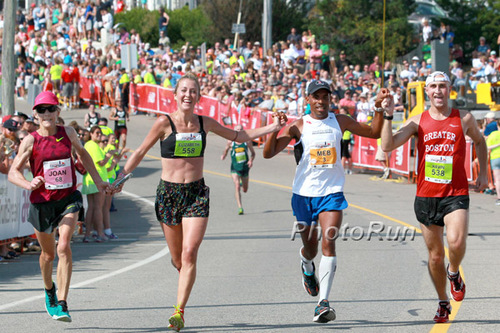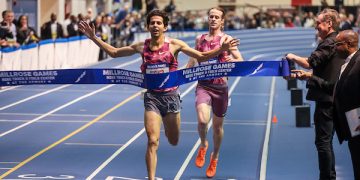Today, at the press conference, Joan Benoit Samuelson, on the thirtieth anniversary of her victory at the 1985 Chicago marathon, did all that she could to run this iconic marathon through the Windy City this year. In her comments before the media this morning, Joan Benoit Samuelson comes across as what she is: a thoughtful pioneer in the women’s running movement, who speaks with her movement and her words.
 Joan Benoit Samuelson with Meb Keflezighi, Falmouth 2014, photo by PhotoRun.net
Joan Benoit Samuelson with Meb Keflezighi, Falmouth 2014, photo by PhotoRun.net
After watching Joan this morning, and then, noting her busy schedule with sponsors over the next couple of days, I thought I would remind us of how Joan Benoit Samuelson reinvented running.
I remember in 1979, when Joan Benoit won the Boston Marathon. The shy Mainer, who had only run one marathon before entering Boston (a 2:50:54 for second place at the 1978 Bermuda Marathon). Joan’s 2:35:15 gave her the title in Boston, and the legend began. How fast was Joan Benoit in her 1979 Boston win: she took eight minutes off the womens’ course record.
Her rise in the marathon world was meteoric. In 1980, Joan took four minutes off her best, winning the Auckland marathon in 2:31:43. In 1981, her return to Boston, Joan Benoit again improved, but did not win, in fact, she placed third, with her 2:30:17.
An achilles surgery slowed her down, but just a bit. Running the Nike OTC Marathon in Eugene, Oregon in 1982, Joan Benoit took four minutes and five seconds off her best, to win in 2:26:42. Joan made the Runner’s World cover that year, as she ran the fast Eugene course, showing not only that she had recovered from her surgery, but that she was, in fact, one of the top women marathoners in the world.
When Joan Benoit returned to Boston in 1983, she was on a literal tear. Her split for 10 miles was under 52 minutes! One of my friends, who ran finished just ahead of Joan, told me what it was like to have the top women in Boston ahead of him for the first ten miles. Running with Kevin Ryan for much of the race, Joan Benoit ripped the course, running 2:22:43, breaking the world record set only the day before, in London by the great Grete Waitz. Joan Benoit had made a statement.
Before the LA Olympics, Nike put some huge murals across the City of the Angels. Nike was reinventing sports marketing and sports advertising. One of the murals showed Joan Benoit, in her Athletics West gear (she was, if not the first, one of the first women in the epic Nike club, Athletics West), winning the 1983 Boston.
Seventeen days before the 1984 Olympic Trials, Joan Benoit had arthroscopic surgery on her knee. Her win in the Trials marathon, thirty seconds ahead of Julie Brown, was another example of the level of focus and the quality of runner that Joan Benoit was (and still is).
The 1983 Boston winner, Greg Meyer related to me on several occassions, just how tought Joan Benoit was. ” I would not train with her every day, Joanie would always run hard.” Coached by Bob Sevene, the combination of Benoit and Sevene worked. Joan’s 2:22:43 was a world record and American record. The WR would last one year.
The course record would last eleven!
After Joan won the 1984 Olympic Trials, the ‘experts’ considered her a good shot for a marathon medal, but with Grete Waitz, Ingrid Kristiansen and Rosa Mota, it would be tough.
I remember watching Joan Benoit take the lead early in the Los Angeles Olympic marathon, the first Olympic marathon for women.
Remember, from 1928 until 1972, women were not allowed to run anything longer than the 800 meters. There were suggested that, and this was from reputable experts, that women running marathons would suffer many things (one result: prolapsed uterus). Percy Cerruty, the famed coach, who some described as mercurial, was quoted as suggesting that a women who could break five minutes for the mile or three hours for the marathon might not be a woman.
But women runners had some supporters.
The 1,500 meters for women was added in 1972.
And, after threats of lawsuits, and much political pressure, the marathon was added in the 1983 World Champs (Grete Waitz won), and the first women’s Olympic marathon would happen in 1984.
 Joan Benoit Samuelson and Shalane Flanagan, photo by PhotoRun.net
Joan Benoit Samuelson and Shalane Flanagan, photo by PhotoRun.net
So, this tiny little women, in a gray colored Kappa uniform, with her running hat on, took the lead early in the marathon. Grete Waitz, World Champion, Ingrid Kristiansen, her Norwegian teammate, and Rosa Mota, European champion, all trailed.
But, in 1984, in Los Angeles, the perfect storm took place.
Joan Benoit should not have won the marathon in Los Angeles, if one asked the experts.
One problem.
No one told Joan Benoit.
To destress Joan, Bob Sevene took Joan to Eugene a few days before the Olympic marathon, and she picked berries to relax. Joan was fit, ready and focused.
Her race in 1984, was amazing. Leading twenty three of twenty-six miles, Joan Benoit took a gamble, and built on it, so gently, but so strongly, that by the time Grete Waitz, Rosa Mota and Ingrid Kristiansen came after her, it was just too late.
Joan Benoit came into the stadium, the 1932 Olympic stadium, to the cheers of a very excited American crowd. The waif like marathoner, had made history. In winning the first Olympic women’s marathon, Joan Benoit Samuelson made history.
In April 1985, Ingrid Kristiansen broke the World record set by Joan Benoit Samuelson in 1983, running 2:21:06.
 Joan Benoit Samuelson, photo by PhotoRun.net
Joan Benoit Samuelson, photo by PhotoRun.net
The 1985 Chicago Marathon was a battle between Joan Benoit Samuelson and Ingrid Kristiansen. In an epic struggle, like two boxers duking it out for over two hours, Joan Benoit Samuelson broke Kristiansen, winning in 2:21:21, a new American record, which stood for 18 years.
That race was up for grabs for nearly twenty miles. With two of the best marathoners in the world battling through the streets of Chicago, Joan took Ingrid to a place that few other marathoners had been. The race put it all on the line for both of them. It was a great race to watch on TV.
Joan Benoit Samuelson has influenced several generations of women runners. She had qualified for seven Olympic Trials, coming quiet close to making her eighth Trials.
She leads by example.
Mostly, what Joan has done, in speaking to women at events like the Nike Half Marathon in San Francisco, is show that a mother of two, and wife, can meet with runners and walkers around the world, and change generations with her running.
 Scott and Joan Samuelson, photo by PhotoRun.net
Scott and Joan Samuelson, photo by PhotoRun.net
Joan Benoit Samuelson comes from hardy stock. Her father fought in World War 2 with the famed U.S. ski troops in Northern Italy. Joan still runs hard, compromising, in her heart and mind, only as much as her body makes her. This fall, after a nice build up of 80 miles a week, and some pretty good races, Joan got sick. Her family probably nudged her a bit to be careful. With a son (Anders) and a daughter (Abby) and a loving husband (Scott), Joan has a wonderful life, now running and talking about running as part of her contract with Nike, her long time sponsor and partner.
How special is Joan Benoit Samuelson?
To me, she reinvented the sport of running.
One foot step at a time…
For women, Joan Benoit Samuelson is that link between runners like Jacqueline Hansen (WR holder, coach, champion of women’s rights), the late Miki Gorman and runners the age of Joan’s daugther, Abby (mid twenties).
Her running is as important to her as breathing.
Thirty years ago this weekend, one year after her Olympic win, Joan Benoit Samuelson was challenged by WR holder Ingrid Kristiansen. Joan took on that challenge and changed running once again.
And we were in awe.
Some of us still are…





















